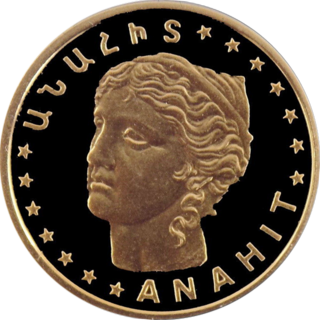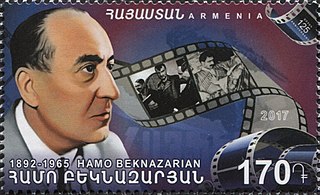
Vahagn or Vahakn, also known as Vahagn Vishapakagh, is a warrior god in Armenian mythology. Scholars consider him to be either the thunder, or sun and fire god of the pre-Christian Armenian pantheon, as well as the god of war, bravery and victory. He formed a triad with Aramazd and Anahit. Vahagn is etymologically derived from *Varhraγn, the Parthian name for the Indo-Iranian god Verethragna, although there are key differences between the two deities.

Armenian mythology originated in ancient Indo-European traditions, specifically Proto-Armenian, and gradually incorporated Hurro-Urartian, Mesopotamian, Iranian, and Greek beliefs and deities.

Anahit was the goddess of fertility and healing, wisdom and water in Armenian mythology. In early periods she was the goddess of war. By the 5th century BCE she was the main deity in Armenia along with Aramazd. The Armenian goddess Anahit is related to the similar Iranian goddess Anahita. Anahit's worship, most likely borrowed from the Iranians during the Median invasion or the early Achaemenid period, was of paramount significance in Armenia. Artaxias I erected statues of Anahit, and promulgated orders to worship them.
Astłik was the Armenian goddess of fertility and love, and consort of Vahagn. In the later pre-Christian period she became the goddess of love, maidenly beauty, and of water sources and springs.

Hamo Beknazarian, also known as Hamo Bek-Nazarov or Amo Bek-Nazarian, was a Soviet Armenian film director, actor and screenwriter.

Anahita is the Old Persian form of the name of an Iranian goddess and appears in complete and earlier form as Aredvi Sura Anahita, the Avestan name of an Indo-Iranian cosmological figure venerated as the divinity of "the Waters" (Aban) and hence associated with fertility, healing and wisdom. There is also a temple named Anahita in Iran. Aredvi Sura Anahita is Ardwisur Anahid or Nahid (ناهید) in Middle and Modern Persian, and Anahit in Armenian. An iconic shrine cult of Aredvi Sura Anahita was, together with other shrine cults, "introduced apparently in the 4th century BCE and lasted until it was suppressed in the wake of an iconoclastic movement under the Sassanids." The symbol of goddess Anahita is the Lotus flower. Lotus Festival is an Iranian festival that is held on the end of the first week of July. Holding this festival at this time was probably based on the blooming of lotus flowers at the beginning of summer.
Nane was an Armenian mother goddess, as well as the goddess of war and wisdom.
Anahit is goddess of fertility and healing, wisdom and water in Iranian and Armenian mythology.

The Satala Aphrodite is an over-life-sized head of an ancient Hellenistic statue discovered in Satala. Probably created in the 2nd or 1st century BC in Asia Minor, it was acquired by the British Museum in 1873, a year after its discovery. It has been widely admired since its discovery and likened to the Aphrodite of Knidos by some scholars.
Duzgin Baba is a religious figure among Alevi Kurds, especially in the Tunceli Province. He also symbolizes a mountain in Nazımiye, nearby the village Qil. The people believe that he disappeared at the top of this mountain, which is known as Kemerê Duzgıni, Bimbarek (holy) or Kemerê Bımbareki in Zazaki. According to local narrations he is the son of sayyid Kures/Kureş who was an ancestor of Kureşan community and his real name is not Duzgın, it is Haydar or Shah Haydar. But some researches suggest the opposite of this view.
Nahid is the Persian name for the Iranian goddess Anahita.

The Yerevan State Institute of Theatre and Cinematography is a state university and higher education institution based in Yerevan, the capital of Armenia.
Anahita is an Iranian goddess.

Yeva is a 2017 Armenian drama film directed by Armenian-Iranian filmmaker Anahit Abad. The joint Iranian and Armenian produced film financed by the National Cinema Center of Armenia and Iran's Farabi Cinema Foundation is Anahid Abad's first long film feature. It was selected as the Armenian entry for the Best Foreign Language Film at the 90th Academy Awards held in 2018 but it was not nominated.
The Temple of Anahita was an ancient fire temple in Istakhr dedicated to the worship of the Iranian goddess Anahid.
Adur-Anahid was a high-ranking 3rd-century Iranian noblewoman from the royal Sasanian family, who wielded the title of Queen of Queens. She was a daughter of the second Sasanian King of Kings of Iran, Shapur I.
Anahita is a feminine given name named after the ancient Iranian goddess Anahita, associated with fertility, healing and wisdom. The name has increased in usage in recent years along with other mythological names. People named Anahita include:
This page is based on this
Wikipedia article Text is available under the
CC BY-SA 4.0 license; additional terms may apply.
Images, videos and audio are available under their respective licenses.






